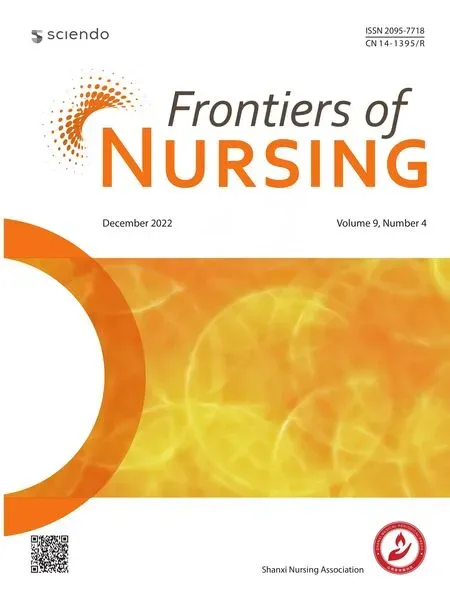Comparison of research hotspots and trends in long-term care for the elderly between China and Australia: a bibliometric analysis†
Min-Li Li, Jcqui Allen, Virgini Plummer*, Yn-Ling Di
aCollege of Nursing, Fujian University of Traditional Chinese Medicine, Fuzhou, Fujian 350122, China
bSchool of Nursing and Midwifery, Monash University, Melbourne 3800, Australia
cSchool of Nursing and Healthcare Professions, Federation University, Melbourne 859, Australia
Abstract: Objective: To explore the current status and development of long-term care (LTC) research in terms of publications in China and Australia, to identify the major contributing authors and institutions, and to compare the research hotspots and trends between China and Australia in order to encourage informed collaborations and work in future.Methods: We collected bibliometric data on the LTC of the elderly in China and Australia from 2009 to 2020 using Chinese National Knowledge Infrastructure (CNKI) and Web of Science (WOS). CiteSpace software was used to analyze co-authorships, co-institutions, and co-keywords.Results: A total of 826 articles in Chinese and 393 in English were included for analysis. The total number of publications showed an upward trend in both countries. The top 10 productive researchers and institutions in China and Australia were identified, and their collaboration network was revealed. Then, the knowledge maps of cooccurring keywords, respectively, showed the hotspots of “LTC insurance, disabled elderly, combination of medical and health care, nursing home” and “nursing home, dementia, quality of life, intervention” in China and Australia. Strong citation burst keywords illustrated the emerging trends of “combination of medical and health care, healthy aging” in China and “polypharmacy, prevention” in Australia.Conclusions: This article provided an insight into LTC of the elderly in China and Australia, and research in this field is developing rapidly and is being increasingly valued. The findings will be useful for future researchers to facilitate collaboration, identify new topics, and support urgently needed research of LTC in China.
Keywords: Australia • bibliometric analysis • China • CiteSpace • elderly • knowledge map • long-term care
1. Introduction
Globally, many countries are required to adapt to the health care needs of an aging population. According to a report released by the World Health Organization (WHO) for the International Day of Older Persons, the number of people >60 years is expected to double by 2050.1An aging population brings in a higher demand for primary health care and long-term care (LTC),2requiring more elderly-friendly social environment, health services, and insurance systems.3The US National Institute on Aging (NIA) has defined LTC as a variety of services designed to help people live as independently and safely as possible when they experience mobility difficulties and when they can no longer perform everyday activities of daily living (ADL) on their own, including bathing, dressing, grooming, using the toilet, and eating.4
China is a developing country with a rapidly aging population. In 2018, 249 millions of populations were >60 years, accounting for 17.9% of the total population.5It is estimated that the number of elderly Chinese will reach a peak of 487 million by 2050, accounting for 34.9% of the total population.6Among them, 27 million elderly Chinese aged ≥65 years will have difficulty with ADLs and need LTC services.7More than 23 million Chinese people aged ≥80 years will require assistance in their daily living activities. This segment of the Chinese population will be the largest group in need of LTC.8The care of aged Chinese has been further complicated by the “one-child-per-couple” policy, which has reduced families’ abilities to care for older people at home.9Hence, LTC is increasingly being recognized as an alternative care option for older adults in China.10
Due to China’s over-burdened health care and agedcare systems, the number of nursing home beds can currently meet the needs of only 2.72% of the elderly.11By contrast, the number of nursing home beds in developed countries can meet the needs of 5% of older adults.11In response to these challenges, the Chinese government is exploring different models of LTC service,12which has prompted further research into LTC in China, and the establishment of research teams with a record of success in this area. China is focusing on building a culturally relevant LTC system, while at the same time, learning about similar experiences from other countries.
Australia is a developed country with an aging population. In 2018, 15.9% of Australians (3.9 million) were aged 65 years and older,13and it is estimated that the elderly population will account for 22% of the population (8.8 million) in 2057.14According to a recent Australian Bureau of Statistics (ABS) survey, 35.4% of older Australians experienced disability as a severe or profound core activity limitation,13which means they require additional service support from LTC services.
LTC services in Australia (also referred to as aged care and aged-care services15) have undergone major structural changes in service delivery and funding since 2015,16resulting in the introduction of a consumerdirected care model in community aged care. Australia has a comprehensive aged-care system ranging from supportive community-based services to residential aged care.15Community-based services emphasize the central role of older adults and their family in their own decisions about their care. The model provides care to people with functional restrictions to support continued living at home,17while residential aged care provides accommodation and aged care to people requiring ongoing personal care for chronic impairment or reduced independence of daily living.18Limited government-subsidized professional nursing and allied health services are available to older Australians in residential aged-care facilities outside government-funded sub-acute care models.18
Researchers from China and Australia have shown considerable interest in LTC and have developed and evaluated a range of care models. However, an analysis of the existing publication has not been undertaken. Such an analysis is necessary to have a comprehensive understanding of LTC research in these two countries. The aim of this analysis is to explore the current status and development of LTC research with regard to publications, to identify the major contributing authors and institutions, and to compare the research hotspots and trends on LTC of the elderly between China and Australia in order to encourage informed collaborations and work in future.
2. Methods
2.1. Design
Bibliometrics and visualization methods were employed for this analytical study.
2.2. Data collection
A literature search from China (Chinese) and Australia (English) was conducted on 25 November 2020. Chinese data were retrieved from Chinese National Knowledge Infrastructure (CNKI) using the following searching strategy: subject = (long-term care Or longterm support Or long-term service Or LTC) And (aged Or elderly Or old); Language: Chinese; Publication year: from 2010 to 2020; Publication type: journal articles, while the English literature data were collected from Web of Science (WOS) Core Collection using the following retrieval strategy: TS=(“long-term care“ OR “long-term support” OR “long-term service” OR “long-term aged care” OR “LTC”) AND TS=(“aged” OR “elderly” OR “old” OR “older” OR “geriatric”); Language: (English);Document type: (Article); Countries/Regions: (AUSTRALIA);Timespan: 2010-2020.
Then, two bilingual authors independently screened the literature against the inclusion criteria: (1) published journal articles on LTC for the elderly and (2) articles published from 2010 to 2020. We excluded the following articles: (1) reviews, letters, news reports, and bibliometric analyses; (2) articles unrelated to the topic; (3) duplicated publications; and (4) articles without author, keyword, or abstract.
2.3. Data analysis
We conducted a bibliometric analysis, which is a statistical analysis, to evaluate and quantify the literature; this method is widely applied in different fields to identify core researchers, institutions, journals, and countries, as well as the geographic distributions and international collaborations. CiteSpace software (5.5 R2) was used to perform visualization analysis of the data. Knowledge maps of authorship, institution, and keyword were generated. The parameters of software were set as follows: time slicing (2010–2020), years per slice (1), term source (all selection), node type (institution, keywords, and author), selection criteria (top 30), thresholding (2, 2, 20), and pruning (pathfinder).
3. Results
3.1. Publication outputs
In total, we retrieved 826 Chinese articles and 393 English articles for analysis. Both China and Australia showed an upward trend in the total number of publications from 2010 to 2020, with some fluctuations (Figure 1).
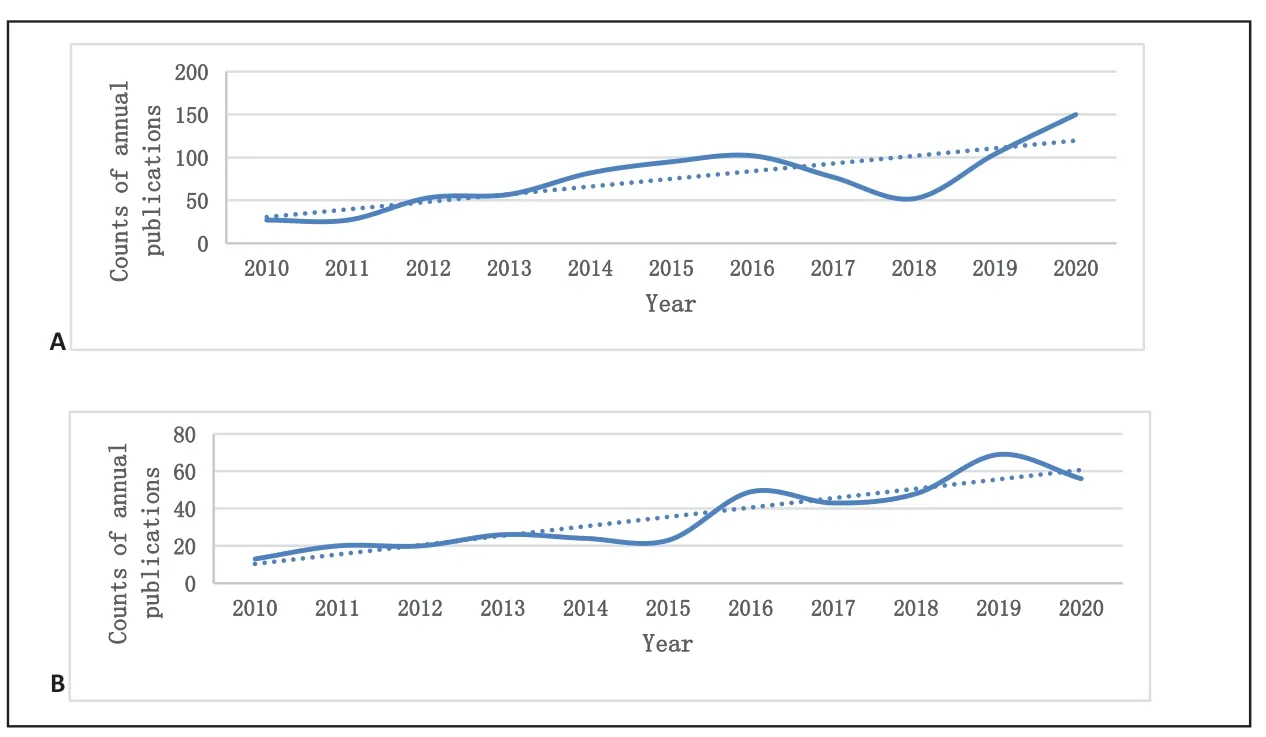
Figure 1. Annual publications of China (A) and Australia (B) from 2010 to 2020.
3.2. Analysis of co-authorship
The top 10 authors with the highest number of publications in LTC research from China and Australia are listed in Table 1. The inclusion of two authors in the same article was treated as one cooperation, and the knowledge maps of the co-authorship network are shown in Figures 2A,B. From Figure 2A, we can notice some productive authors intended to cooperate with others to create a research group or had close cooperative relationship with each other, for example, Yuhuan Wang, Weiwei Hou, and Fangchao Huang of Shihezi University built a relatively stable collaboration network. In Figure 2B, there were already some collaboration networks in place, and authors had extensive cooperation with each other, for example, Tanya Davison worked closely with David Mellor, Gery Karantzas, and David Kissane.
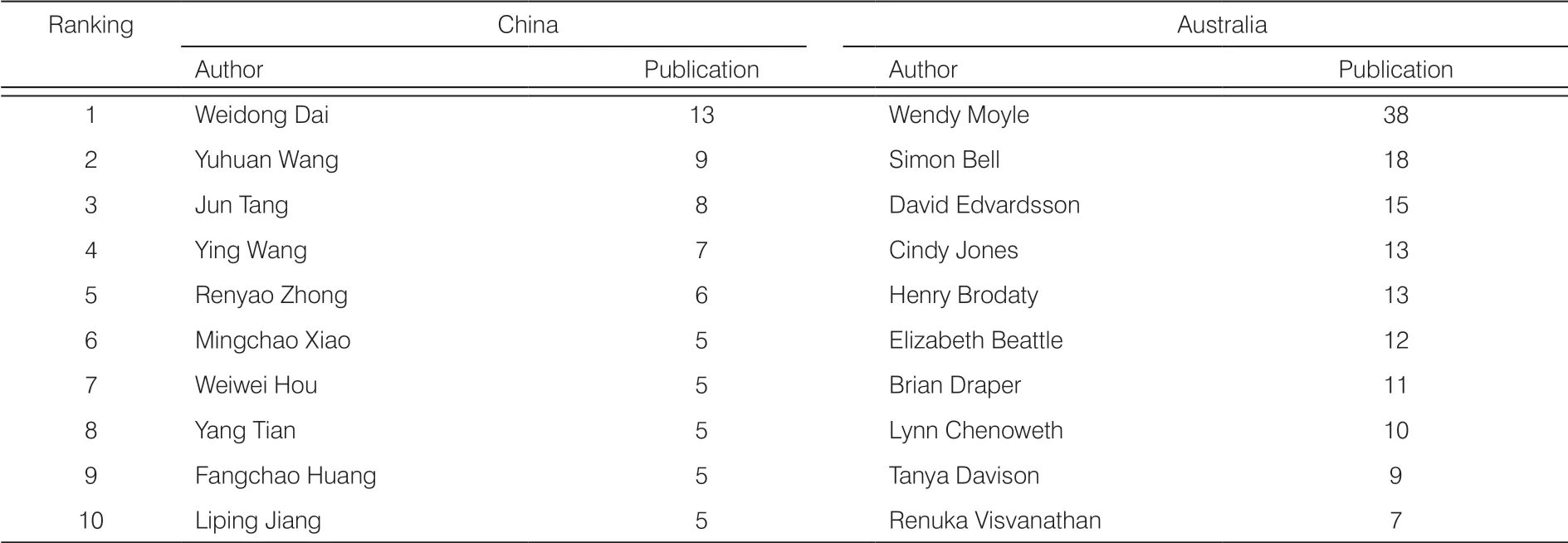
Table 1. Top 10 productive authors according to the number of publications in China and Australia from 2010 to 2020.
3.3. Analysis of co-institution
Table 2 presents the top 10 institutions in terms of publications from China and Australia. Institutions include universities and organizations conducting research. The inclusion of two institutions in the same article was considered as one cooperation. Figures 3A,B shows the knowledge maps of co-institution in China and Australia. In China, Fudan University had cooperation with other institutions in Shanghai, such as Shanghai Jiao Tong University, while Central South University and Yangzhou University had research partnership. Otherwise, there was a weak cooperation between the institutions. Figure 3B displays more frequent and closer cooperative relationships, and almost all the institutions had some degree of collaboration with others; for example, the research partners of Monash University have included Deakin University, the University of South Australia, and the Swinburne University of Technology. Some research organizations from Australia and other countries have built international networks. For instance, Stockholm University in Sweden is a partner of the University of Tasmania, Austin Health in the Australian state of Victoria, and Hornsby Ku-ring-gai Hospital in the Australian state of New South Wales.
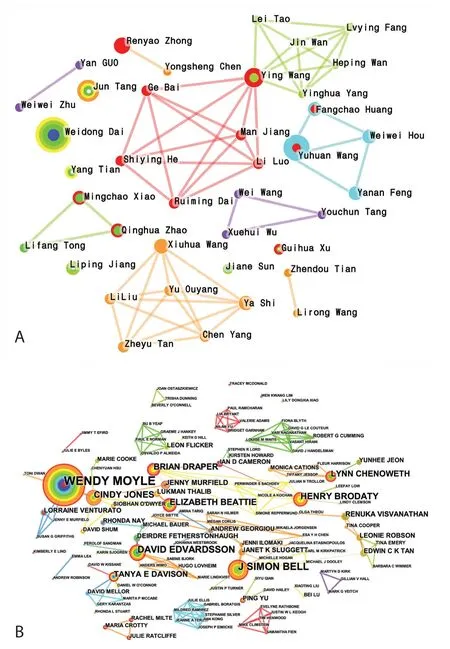
Figure 2. Collaboration network of some productive authors related to LTC research in China (A) and Australia (B). LTC, long-term care.
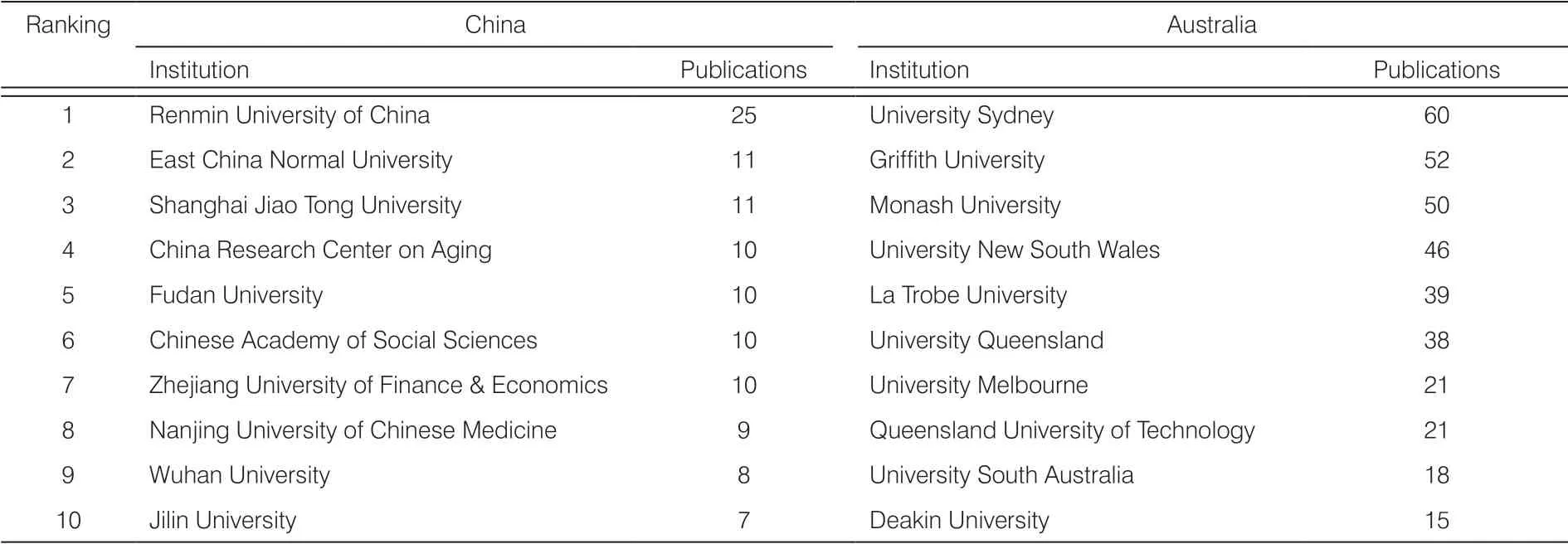
Table 2. Top 10 productive institutions in terms of publications from China and Australia between 2010 and 2020.

Figure 3. Collaboration network of some important institutions in China (A) and Australia (B).
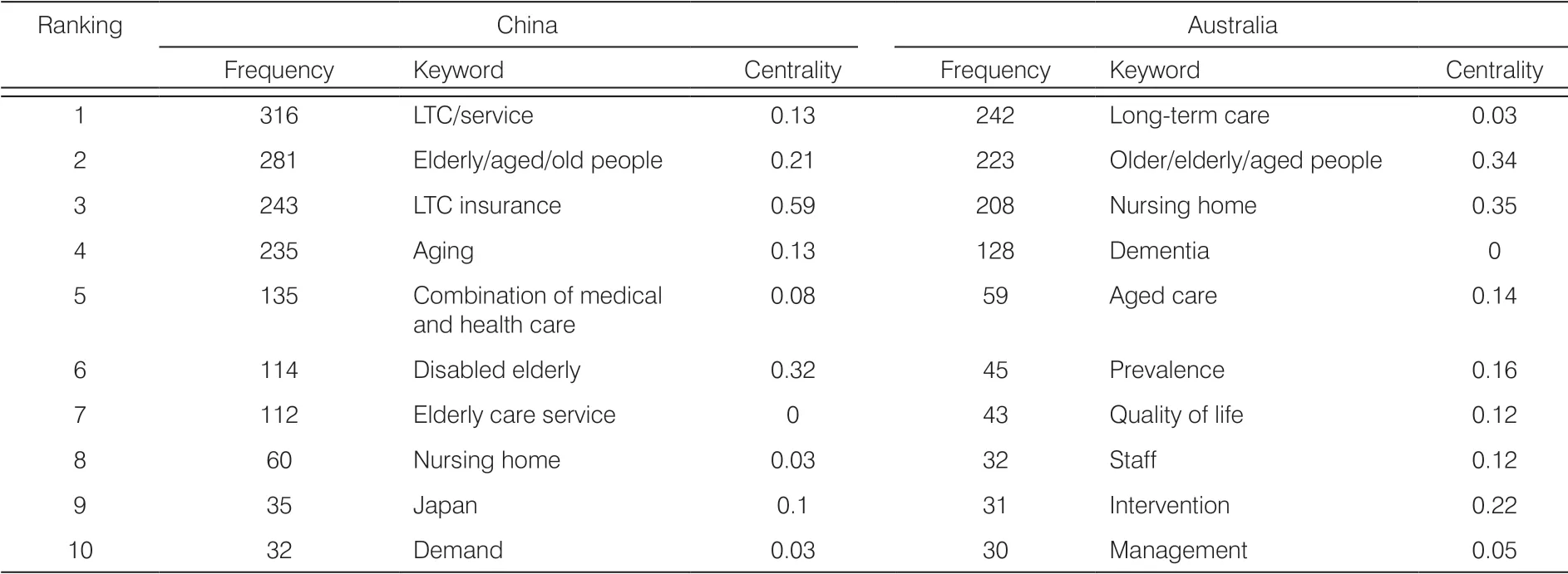
Table 3. Top 10 keywords according to frequency related to LTC research in China and Australia from 2010 to 2020.
3.4. Analysis of cooccurring and burst keywords
Analysis of keyword cooccurrence reflects hot topics in a research field. Figures 4A,B illustrates the analysis of keywords. According to the frequency, Table 3 shows the top 10 keywords in both Chinese and English data, from which we could see keywords with the highest frequency in China including “LTC insurance, aging, disabled elderly, combination of medical and health care, nursing home”. In the Australian studies, the most frequent keywords included “nursing home, dementia, quality of life, intervention”. Burst keywords are the keywords that were cited frequently over time. Burst keywords identify the emerging trends, and the strongest bursts indicate frontier topics in a research area. Figure 5 illustrates the top keywords with the strongest citation bursts between 2010 and 2020 in Chinese and Australian LTC publications.
4. Discussion
The results of the analysis identified a range of research collaborations, authors and institutions, hotspots, and emerging trends that focused on LTC for the elderly in China and Australia. Several groups of accomplished researchers from both the countries have been devoted to this research field over the last decade. The number of publications has increased over the last 10 years, especially in China over the last 2 years. In China, LTC policies represent the new frontier of public response to demographic change and economic development,19and this is likely to remain a prominent area of research and publication in the coming years.
4.1. Establishing collaboration network
Findings from this study will support other researchers to identify potential collaborators for future research. Table 1 and Figure 2A list some highly productive authors in China, such as Weidong Dai from Zhejiang University of Finance and Economics, which is one of the most productive institutions in this area from China. His research focused on LTC insurance20that was suggested by the WHO for China to address the issue of providing care to the disabled and elderly people.21Other analysis of the results showed that the collaboration network in China between different institutions seemed to be limited. This situation demonstrates that domestic and international cooperation is needed to form the influential research team of LTC in China.
In Australia, the research network of LTC for the elderly was relatively more closely knit (Figures 2B and 3B). Indeed, there was frequent and close cooperation between researchers of different organizations associated with almost every productive author and institution. In addition, compared with China, Australian LTC research collaboration is more international. This may be because of the similar research and health care systems, cultures, family structures, and economic levels between developed countries.

Figure 4. Keyword cooccurrence maps of LTC research in China (A) and Australia (B). Abbreviation: LTC, long-term care.
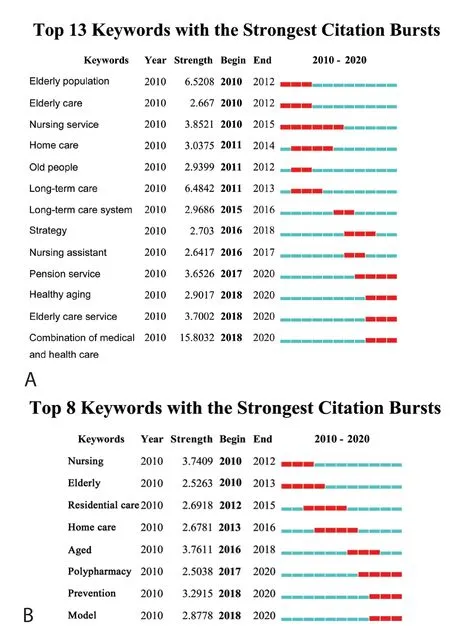
Figure 5. Top keywords with strongest bursts in China (A) and Australia (B).
Demographic changes in China led to a large increase in the number of people in need of LTC.22As a developing country, China is experiencing acute challenges in providing the elderly with LTC services.10However, due to longer life expectancy and low fertility rates in Australia, there is also an increase in the number of older Australians, some of whom will need support by aged care.23The public aged-care system is already under strain, and aged-care demands are expected to put additional pressure on Australian governments equivalent to about 6% of national Gross Domestic Product (GDP) by 2060.24Therefore, when China and Australia face the same challenge, communication and collaboration between researchers and organizations may promote an effective problem-solving mechanism and improve aged-care service provision. Aged-care reforms in Australia and China are evolving. Although residential and community aged care are more developed in Australia than in China, each country can potentially learn from the other through improved research collaboration.
4.2. Hotspots and emerging trends
The hotspot of “LTC insurance” indicated that some Chinese researchers have a strong interest in public subsidization of LTC to improve the care of older adults in the health care system. Chinese policymakers share this interest and aim to establish an LTC insurance policy framework in 2020.20The other hot keywords of “nursing home” and “disabled elderly” then showed the research concerns on service facilities and clients. Here, we must note that the combination of medical and health care was the biggest hit in recent years in China, was also the strongest burst keywords. Combination of medical and health care is the Chinese government’s plan for policy reform of aged care. The purpose is to combine medical and aged-care resources and to encourage the cooperation between medical institutions and aged-care homes.25This is similar to the concept of integrated care and is an emerging model of LTC in China.26Another strong burst word in recent 3 years, as shown in Figure 5A, was healthy aging. They would continue to be the research trends in the coming years.
Compared with the research hotspots in China, Australian researchers were more interested in care of elderly living with dementia. This reflects a focus in Australian aged-care practice on large numbers of older adults in residential care who live with dementia. By contrast, although China has the largest population of people with the diagnosis of dementia in the world, limited research is being conducted in this area. This may reflect the pattern of inadequate diagnosis and management for dementia in China, which are common.27Most Chinese living with dementia receive care at home, rather than in a residential care facility.28In future, Chinese policymakers should plan to attach importance to the prevention, treatment, and care of people with dementia. The research results of dementia care in Australia and elsewhere may be useful for Chinese researchers.
Other hotspots of LTC in Australia included research on workforce and on interventions or management to improve the quality of care in residential aged care. This reflects the focus in Australian LTC facilities, which are required to achieve accreditation to secure government funding by demonstrating their capacity to meet quality aged-care standards as informed by research evidence.29
In Australian studies, two of the most recent keywords with the strongest citation bursts were polypharmacy and prevention, illustrating that they are the future research trends. Polypharmacy, including overuse of medications and more than five medications concurrently, is most common in the elderly because older people often live with several chronic conditions.30According to a study published by Page et al.,31almost one million older Australians are affected by polypharmacy, and the number is increasing with the population aging. Reducing polypharmacy was highlighted by the WHO in its third global patient safety challenge to halve the global burden of medication-related harm.32Thus, future research into polypharmacy and quality use of medicines is an important research trend in improving quality and safety for older adults globally.
5. Conclusions
An overview of research on LTC for the elderly in China and Australia was presented in this article. The information illustrated in this article is useful for strengthening domestic and international cooperation between and within China and Australia. The findings may support researchers to identify new topics and frontiers for future study, as well as guide Chinese and Australian governments in the focused research areas requiring funding support.
LTC is a rapidly developing research area and is being increasingly valued. LTC services enable older people to receive care and support from society consistent with their human rights and human dignity. Quality research collaborations are essential in ensuring the best care possible for older adults in the community and residential care. There is a globally urgent need to improve the system of LTC to optimize quality aged care.
Author’s contributions
ML, JA, and VP contributed to study concept and design; ML and YD acquired the data. ML and YD analyzed and translated the data. ML, JA, and VP drafted the manuscript. VP supervised the entire process. JA provided advice to structure the manuscript. All authors read and approved the final manuscript.
Acknowledgements
We thank Ms. Shuqin Pang, a professor from College of Nursing, Fujian University of Traditional Chinese Medicine, for providing an overview of aged care in China to ML and YD. We also thank Ms. Cassandra Freeman, a subject librarian from medicine, nursing, and HS, Hargrave-Andrew Library Monash University, for instructing on the process of data search.
Ethical approval
Ethical issues are not involved in this study.
Conflicts of interest
All contributing authors declare no conflicts of interest.
- Frontiers of Nursing的其它文章
- Frontiers of Nursing Call for Papers
- Perioperative nursing of a newborn with Beckwith-Wiedemann syndrome
- Combination of diaphragmatic breathing with therapeutic walking exercise to increase peak expiratory flow rate in asthma patients
- Instructors’ caring behaviors, burnout, satisfaction, and academic performance of nursing students in online education and the pandemic era
- Knowledge of reproductive health rights and its associated factors among Wolkite University undergraduate students, Wolkite, southern Ethiopia
- Experiences of Chinese nurses studying for master’s degree in the UK: a qualitative study†

